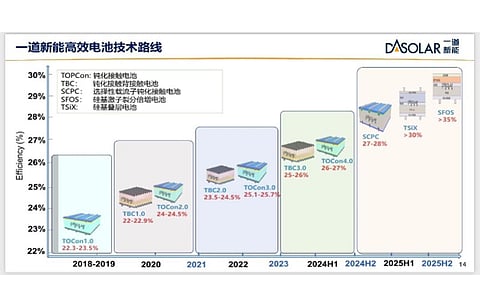

Leading Chinese TOPCon solar production company DAS Solar has unveiled its technical roadmap for the future, moving from n-type TOPCon 3.0 Plus technology era that it currently is into, to TOPCon4.0, TBC, SCPC, TSiX, and finally SFOS in collaboration with the University of New South Wales (UNSW) to exceed 35% cell efficiency.
The manufacturer says this roadmap is not only aimed at further improving the cell efficiency of n-type, but also explores the future with advance layout of cell technology for the 'post-silicon era' that's 'advanced, clear, complete and executable'.
At present, DAS is into mass production of TOPCon 3.0 plus that use i-SE, ut-PolySi and mt-Pass with the highest efficiency hitting 25.8%, laboratory efficiency exceeding 26.24% and open circuit voltage of 730mV. Moving towards TOPCon 4.0, the manufacturer will aim to achieve 26% to 27% efficiency.
It is also simultaneously working on the TBC technology which combines the best of TOPCon and TOPCon-back contact (BC).
These are being developed to place all electrodes on the back of the cell to avoid shading losses of about 3.5% compared to conventional cell with metallization pattern on both sides.
Under testing, DAS counts its TBC 1.0 high efficiency cells to have over 25.2% efficiency. The company plans to launch its TBC modules based on the new generation in H2/2023 when the TOPCon and TBC cell efficiency will be over 27%.
Further on, the roadmap will incorporate selective carrier purification contact (SCPC) cell based on 26% efficiency TOPCon cell structure with highly selective carrier contact passivation materials. This is targeted to lead to 27% to 28% efficiency.
By H1/2025, it will have TSiX industrialization cell efficiency reaching over 30%. It describes this as a new type of silicon-based laminated cell that can greatly increase the open circuit voltage of the cell. It will incorporate low resistance tunneling layer technology in the middle layer of top and bottom cells, conformal deposition technique of top cell on crystalline silicon suede surface, and spectrum allocation techniques for top and bottom cells and metallization technique.
UNSW's Center for Advanced Photovoltaics, headed by Professor Martin Green, will work with DAS Solar to develop 'new ultra-efficient' SFOS solar cells with an efficiency of over 35%, targeted for H2/2025.
It will use DAS Solar's silicon cell structure and 'novel' photoelectric conversion thin-film materials with singlet fission properties developed by UNSW for the exciton multiplication process. DAS says this combination will make solar cells more than 100% quantum efficient leading to a maximum SFOS cell efficiency to exceed 40%, meaning the technology makes best use of the different bands of solar irradiation.
At SNEC 2023, DAS Solar Chairman and President Liu Yong in an exclusive interview with TaiyangNews had hinted towards a collaboration with UNSW to develop a new cell structure (see SNEC Exclusive: DAS Solar Executive Interview).
